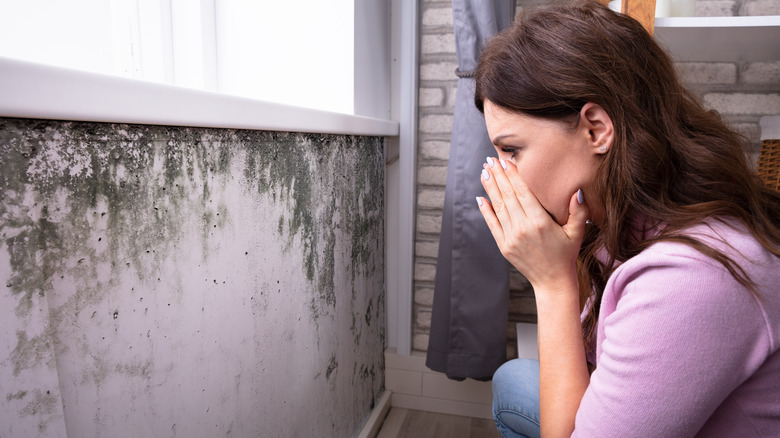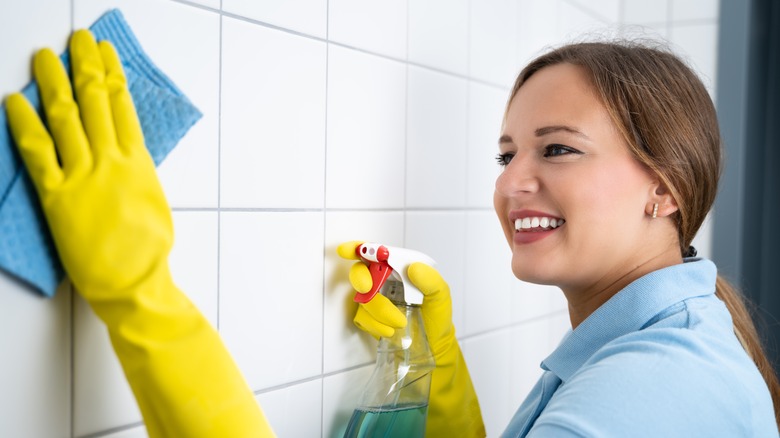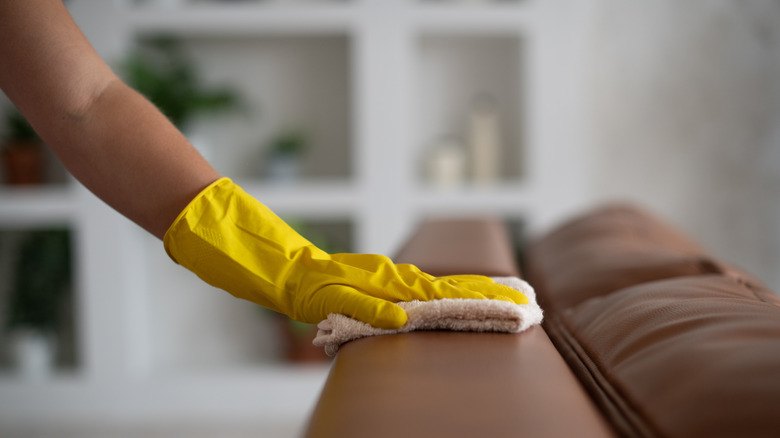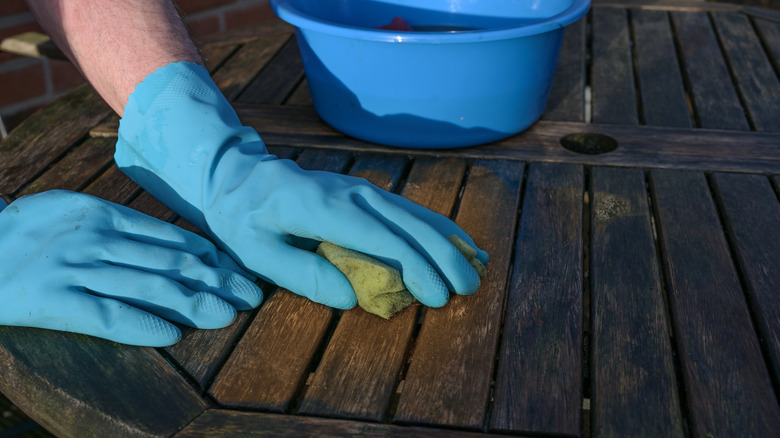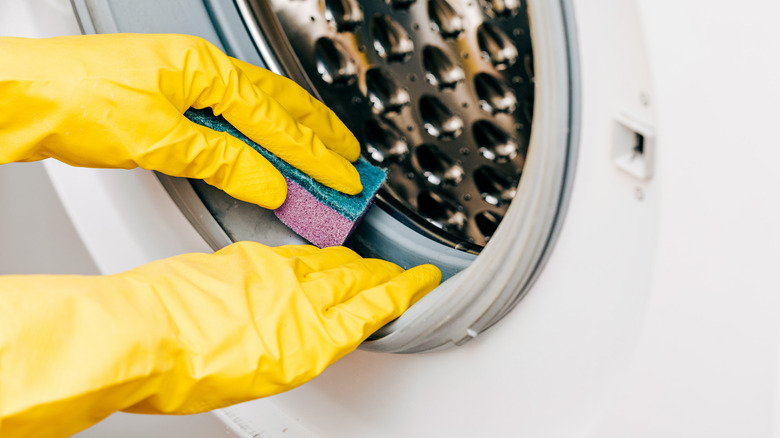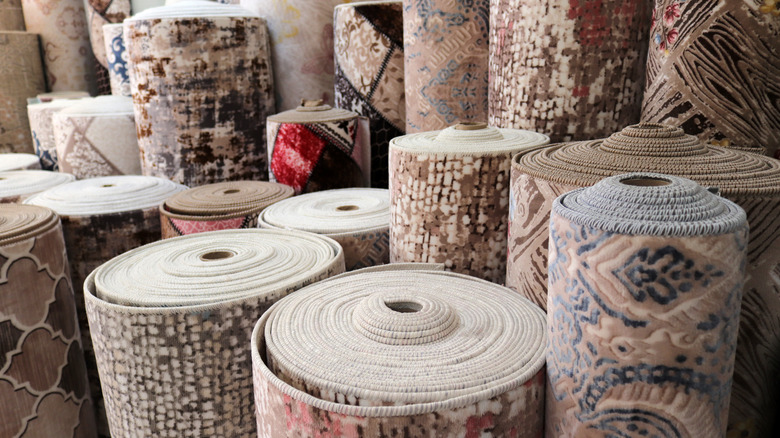The Best Way To Tackle Stubborn Mold
We may receive a commission on purchases made from links.
Mold is a toxic, rapid-spreading fungus with 12 different species; there is green, blue, red, or black mold, per Apartment Guide. Unfortunately, the types responsible for the most damage in homes (such as that weird musty smell coming from your HVAC, tile grout, and peeling wallpaper) are the most toxic, Insider writes. These particular species contain allergens and mycotoxins, the latter of which Green Facts describes as severely poisonous. Each time you feel like you have a cold that won't go away or your asthma worsens mysteriously, blame it on mycotoxins. Other symptoms of mold exposure to mold are wheezing, coughing, skin and lung irritation, runny nose and congestion, and even headache, according to Healthline.
Mold (just like the matrix) is all around us all-year-round, existing as inactive (read: harmless) microscopic spores in the air we breathe. These elusive spores floating abundantly outdoors get blown indoors, especially in windy weather. Once inside, Green Home Solutions explains, spores settle on organic materials such as wood, wallpaper, and fabric, ready to spread by stack effect into areas that provide warmth, darkness, and moisture for growth and reproduction. After a maximum of 14 days in those areas, mold gets activated for the real invasion.
In this post, you'll discover eight effective ways to eliminate stubborn mold for good. Before beginning, consider what the EPA says about not attempting this project yourself if the mold-infested area is wider than 10 feet, your HVAC or sewage systems are already affected, or you're showing symptoms.
Treat moldy tiles with distilled vinegar or baking soda
Regardless of how many days a week you wash them, your toilet and bathroom will always remain prime breeding grounds for fungus because they're often humid, warm, and moist (the three conditions needed for fungus to prosper), especially in summer. Moreover, mold, whether on the surface or grout of tiles, is resistant to the cleaning power of your regular washing soap, AskingLot explains.
According to Expert Home Reports, distilled white vinegar or water-diluted baking soda sprayed directly onto the affected portion lifts and drops molds like death itself. And unlike other options such as bleach and borax, which can be toxic, vinegar or baking soda pose no health threat, nor do they discolor your tiles. Another environmentally-friendly option is white toothpaste or hydrogen peroxide.
Whichever method you go for, let the cleaner sit on the gross invasion for 30 minutes after spraying, before scrubbing away the mess with a bristle brush or a damp sponge. Finally, rinse with clean water. Remember to have your protective glasses, mask or respirator, and gloves on before tackling this project. Psst: Instead of these home remedies, you can purchase mold-rated tiles cleaners such as Microban 24 Bathroom Cleaner.
Clean mold off leather with lemon juice or leather cleaner
Your leather bags, shoes, belts, furniture pieces, car seats, and more are another target for mold. Mind you, when cleaning them it's important to consider the type of leather your items are made of. Suede and untreated leather (read: unprotected leather) get damaged easily, unlike tiles, when cleaned with home remedies like baking soda, alcohol, vinegar, toothpaste, bleach, and alcohol (via MasterClass). On the other hand, treated leather (read: protected leather) is more adaptive and less susceptible to damage.
According to a group discussion between experts on Leather Worker, diluted lemon juice is the most gentle yet powerful remedy for unprotected, delicate types of leather. You simply take the infested shoes or furniture outdoor, spray evenly with diluted lemon juice inside and out (yes, just to make sure you don't miss those elusive spores), and finally wipe with toilet paper or clean pieces of cloth. To salvage leather items, Steal Horse Leather recommends brushing off visible mold first before rubbing with alcohol-soaked foam (strong alcohol must be diluted with water to reduce the harshness and shouldn't be left to sit for long on the item). Alternatively, for all types of leather, you can eliminate mold with Lexol Leather Cleaner and then clean with Leather Honey Leather Conditioner to maintain leather's condition.
Salvage mold-infested wood with soapy water or bleach
According to This Old House, wood is porous, meaning it absorbs moisture and provides a humid environment for mold colonization. Now, just as with leather, it's crucial to understand your wooden pieces before treating them for mold and mildew. This is what we mean; painted wood or any form of finished wood is fungus-impenetrable, so all the mold activities happen only on the surface and can be easily treated with soapy water. Meanwhile, unfinished wood is defenseless, demanding a stronger cleaning agent like bleach to dive into the microscopic holes containing mold.
To salvage mold-colonized wood, Bob Vila explains, first take the wooden piece outdoors to vacuum any loose growth, without further spreading mold on indoor surfaces. Now, wash painted wood with warm soapy water and wipe unprotected wood with a clean piece of rag soaked in either bleach or vinegar, then rinse by dabbing with a wet towel. Finally, air-dry (and sand if needed) wood before moving it back indoors. As always, remember to put on your gloves, respirator or mask, and goggles before engaging in a project like this.
Clean moldy washing machines with hydrogen peroxide and lemon juice
As explained by Mold Help For You, mold is attracted to the deposited food particles and synthetic components of laundry detergents hugging the rubber gasket of your front loader or the basin of your top loader. But if you look closely enough, you might also find the washing machine drum and the draining hose are also mold-infested. In short, the internal environment of washing machines is warm, damp, dark, and packed with mold food, and is not always an easy spot to clean during a regular maintenance session. Now, while products like Affresh Washing Machine Cleaner and Supreme Clean Probiotic Washing Machine Cleaner time and again eliminate mold and mold odor like a charm, you can also create a powerful DIY mold-treating solution for washing machines.
Puro Clean instructs to mix 1/2 cup of hydrogen peroxide and 1/4 cup of lemon juice in 2 cups of water. This mixture is to be sprayed directly onto the colony and scrubbed with a bristle brush. After that, rinse and towel-dry. You should also pour the mixture into the washer drum and the draining hose, select a normal wash cycle and set the water temperature to normal, and finally allow it to run for three to five minutes before rinsing with clean water. FYI, The Spruce says you should always start with an empty washer, so you might need to empty the dispenser drawers and the washer as a whole first.
Eliminate mold from fabrics using borax powder or bleach
Right now, as you read this, there's probably an old towel breeding mold at the bottom of your laundry hamper that you're not aware of. Additionally, it turns out you're not the only one in love with the warmth of your blankets — they are paradise for mold, too. Generally, damp fabrics, when left unwashed for too long (especially in the dark), promote the growth of moldy organisms. So, if you're treating your home for mold or mildew, you better be ready to give special care to both clothing and upholstery, Love To Know warns.
For all fabrics, Cleanipedia explains, refer to the wash-care warnings on their labels to confirm the proper washing conditions. With this done, pre-treat fabrics by brushing off loose mold with any soft scrubbing tool. Now, for white fabrics, wash with bleach inside a washing machine set at the temperature prescribed for the fabric. For colored clothes, replace bleach with 1/2 cup borax powder diluted in 2 cups of warm water. And as for upholstery that's not washing machine-friendly, brush or rub the affected portions with diluted borax and rinse.
Get rid of carpet mold naturally or chemically
The two best solutions for mold-infested carpets are to either leave it to the professionals or replace the carpet — a price most of us are unlikely willing to pay. However, if the invasion is minimal (that is, not covering more than 10 feet of the carpet), there are two DIY cleaning options at your disposal. You can purchase ImmunoLytics Mold Test Kit to detect how far those unhealthy organisms have gone on your carpets. Anyway, before proceeding with the treatment, don your protective gear and bring the infested carpets outdoors. Done that? Great. Let's get to work.
Option number one: Go natural by spraying with tea tree oil. Treehugger says that tea tree oil is a powerful antifungal ingredient; 2 teaspoons into 2 cups of water makes a good mold-killing spray. Option number two: Go synthetic with anti-mold products. Oh So Spotless recommends Zep High Traffic Carpet Cleaner or any other carpet cleaner specially formulated to eliminate mold. Having selected your option, Bob Vila explains to first remove visible mold into a dust bag by scrubbing the surface of the carpets with a hard brush. With that done, spray the affected area from 6 inches away with your chosen anti-fungal spray, front and back. Finally, soak excess spray with a rag and allow carpets to dry for 24 hours before taking them back in.
Call professional cleaners
Honestly, this is your best bet when dealing with a widespread mold infestation larger than 10 feet. However, this is most important when remediating mold-invaded HVAC (heater, ventilator, and air conditioner), air ducts, carpets, rugs, and cars (via Certified IAQ Professionals). Professional cleaners are trained to locate the main source of the problem, fish out the hidden spots which would have eluded you, and eliminate mold once and for all. This promises better health and saves you money in the end.
However, it's important to choose a company that knows its stuff. In Restoration Master Finder's guide on choosing a mold remediation professional — that you can trust with your life (we made that part up) — emphasis is on looking into the company's services to understand what you're getting. Ideally, beyond mold removal, they should offer other important services such as initial and final inspection, mold containment, and service quotations. You should also carry out background checks on the company, such as reading customer reviews.
